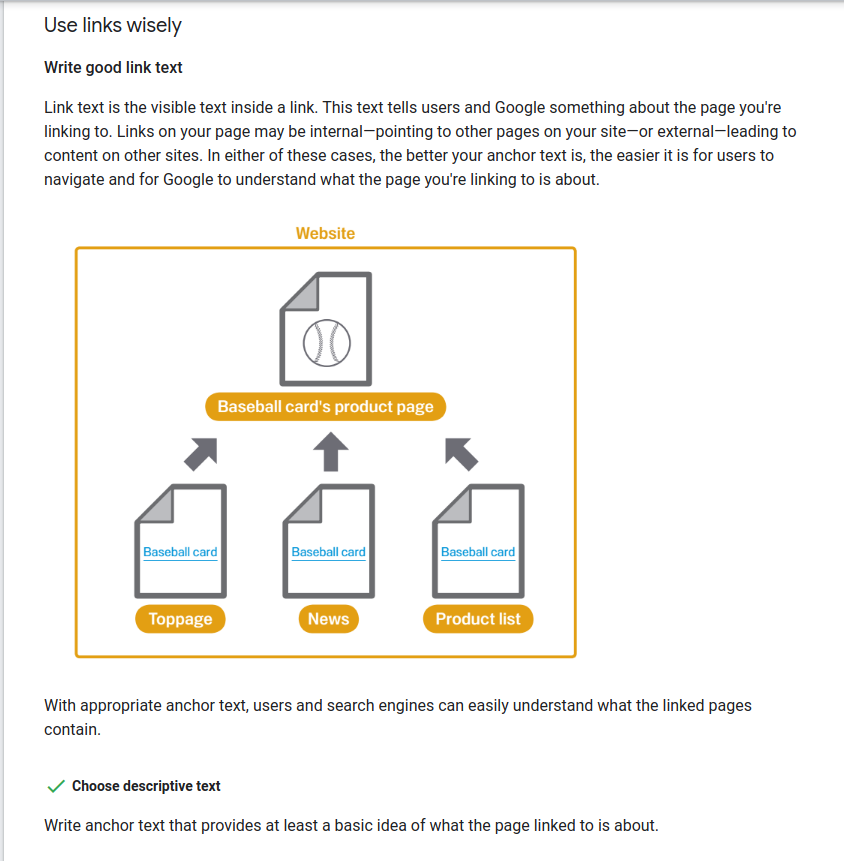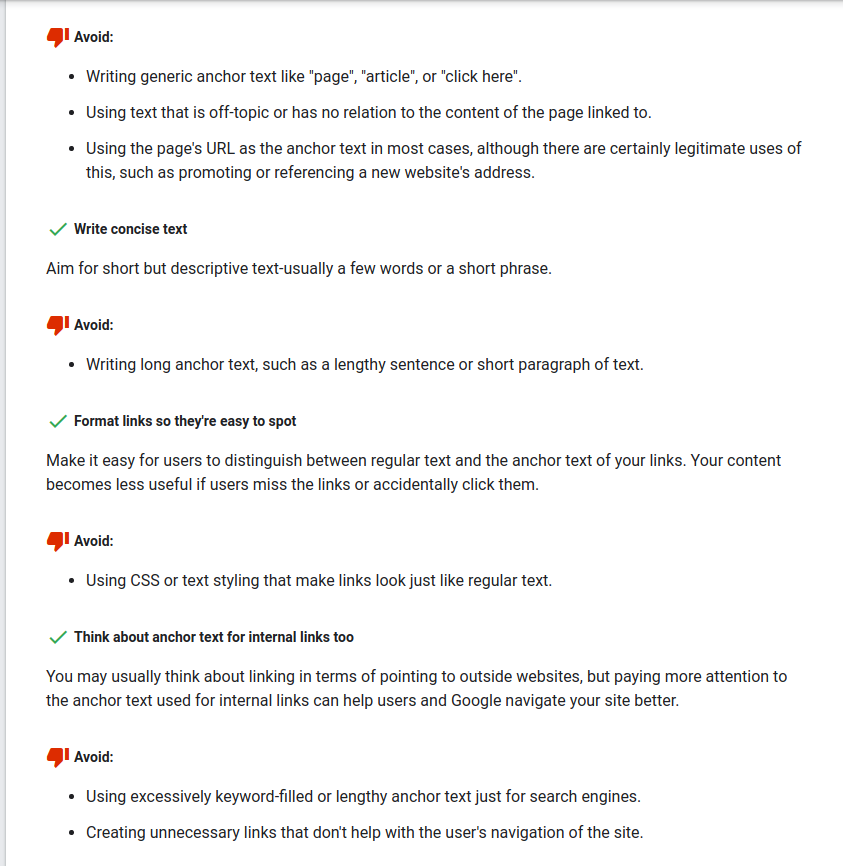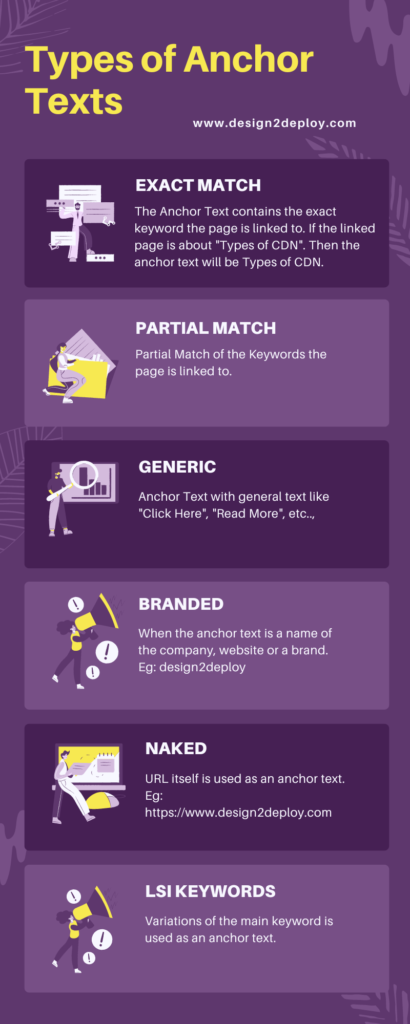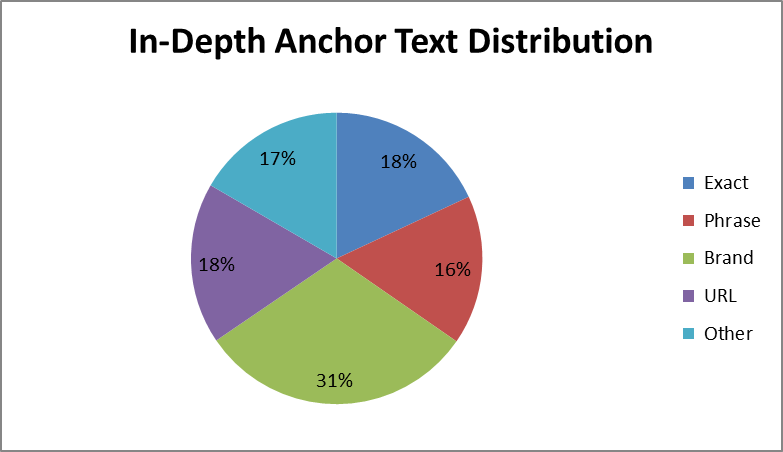An anchor text is a link that is highlighted and takes visitors to a new resource or page when clicked on. Usually, it is colored to differentiate it from the rest of the text. An anchor text is enclosed within <a> tags in HTML.
Here is an example of an anchor text ‘ <a href=”https://design2deploy.com”> web designing studio </a>’
In this article, you can find detailed information about What anchor text is, Types of anchor text, distribution, and How anchor text affects SEO score.
Table of Contents
Why is anchor text a big deal?
Using the correct phrase for your anchor text is important for user experience and accessibility.

Anchor text is also a significant SEO factor because they play a major role in making a site accessible better.
Which of the following anchor text is easy to understand? Obviously, the second anchor text (dog toys) is more meaningful and depicts what the linked content is about.

Your anchor text should be descriptive and not be generalized or just mention an action like click here. It should explain to you the content where you will be taken to on clicking it.
Just a “Click here” for a visually impaired person will convey nothing about what action will be performed when a link or button is clicked.
Whereas a more specific and descriptive anchor text like “About Us” will assist them better in understanding the result of their actions.
How Does Anchor Text Affect SEO?
Anchor Text helps you to understand more about what a page is all about. A perfectly drafted and targeted anchor text helps your site rank better and also get more traffic.
How does a simple anchor text determines the ranking of your webpage for a keyword? Let’s say you have a blog post about the “10 best online games.” A page has linked to this blog post with an anchor text, best online games.
This gives google very little indication that your blog post has content related to the best online games.
If several other sites link to the same post with more or less similar anchor texts like online games, top 10 online games, games to try, etc.., Google becomes pretty confident that your blog is about online games.

And now if people search for this particular keyword, the chances of google showing your blog post on the first few pages are high (provided you also have your other SEO factors right),
On the contrary, if the website that linked your blog post, uses completely irrelevant anchor texts, google gets confused about what exactly is the content of your blog post and your blog post will never rank for any keyword in general.
Google has explicitly mentioned in its patent that anchor text influences the ranking and it is one of the crucial and undervalued ranking factors.
A Similarly undervalued ranking factor is the Alt text of Images. They are mostly unnoticed and not a lot of people put the effort into getting them right.
A Decade back, every website and blog use keyword-rich anchor text. Google revised its algorithm and introduced the First Update of the Penguin Algorithm.
After this algorithmic update, Google started penalizing every website that used keyword-rich anchor text to a greater extent. A lot of bloggers saw a great downfall in their traffic.

And with every new rollout of google algorithm updates, they started to become more stringent on keyword stuffing.
Not just the anchor text, but also the text surrounding it plays a major role in ranking.
One of Google’s patents says that the Data surrounding the link both on the left and right side of the link and the anchor text associated with the link will be used to determine the overall context of the link.
Google expects anchor text to be specific about what resource will be displayed when a visitor clicks on it.
Google in its SEO Starter Guide has clearly mentioned that an anchor text should
i) Use descriptive text – This should provide users a gist about what the content linked to is about.
ii) Have concise words – Never try to stuff your keywords in your anchor text. Keep them concise, and meaningful.
iii) Keep it short – Also, make your anchor text short and to the point, Don’t make your anchor text long.
iv) Make your links obvious – Highlight your anchor text with bold and bright colors and make it stand out from the rest of the text.
Types of anchor text
There are several types and variations of anchor text. Here we have listed them all with their explanation and an example for better understanding.
a) Partial match – A Partial Match anchor text contains a part of the keyword of the linked Page. If the linked page is about Different Types of Diets. The anchor text might be How Diet Helps. Here the keyword diet from the linked page is being used. But not all the words.
b) Exact match – Using exactly the same word or phrase that the linked page is targeting or is about. Eg: If there is a post on different types of diets. The anchor text would be exactly the same that is, Different types of diets.

c) Generic – These anchor texts are the ones that you can find almost everywhere. Anchor texts with common and generic words like Click Here, Read More, etc.., are a few examples of generic anchor texts.
d) Branded – Using the name of a brand or a company as it is as an anchor text. An example would be Coca-Cola, Dominos, etc.., These types of links are hard to build. You can use platforms like HARO to build branded anchor text for your website.
e) LSI – Using the related keyword phrases within the anchor text. This type of anchor text produces a high click-through rate. At the same time, it is possible for your site to get penalized if you overuse this magic wand.
f) Naked – The actual link will be used as anchor text without any additional keywords. Example: https://design2deploy.com is a naked anchor text.
g) Image – The image acts as a link. Google uses the alt tag of your image as an anchor text if you are linking from an image to your website.
Google not just looks for your anchor text but also the context and the phrases around your anchor text to make sure that the anchor text fits naturally in the content. Co-Occurrence helps in achieving this.
Instead of using exact match anchor texts, try to place your keywords close to your anchor text. This not only makes your link look more natural but also helps on-page SEO.
Anchor Text Distribution
The ratio of anchor text distribution varies for every post and page. There is no one size fits all rule. So, how can you find the perfect anchor text distribution ratio for your niche?
Using Trial and error!
SEO comes with experience and practice and not just from theoretical knowledge. To find the exact anchor text destruction that works best for your niche, you should try out different ratios and find the one that outperforms all.

Try to reverse engineer your competitor’s well-performing posts. You can use various SEO tools for this. And replicate the ratio that works wonders for them. Maybe it can work for you too. Don’t try to reinvent the wheel every time, go with what mostly works for the top-ranking sites in your niche and adapt them.
Don’t make your links look unnatural. A mix-and-match of different links usually works better for SEO
It is important to have all these types of anchor texts in your content. Each type of anchor text should be distributed within the content in a certain ratio to make it look more natural and also helps on-page SEO.
The ratio depends on the type of articles you publish and also what works for your content the best. Try using various distribution ratios to find the one that suits your content type. Overdosage of any kind of anchor text can lead to google penalizing your website.
Wrapping Up
More than anchor texts, what matters the most is the quality of your content and content and the authority of the website to link to.
Whenever you link to any website, do some research to understand more about the website, its quality, and how relevant it is to your niche.
Linking to already penalized and scammy sites can have a significant negative impact on your site as well.
Work on anchor text that you can control and not on the ones you can’t control. Produce quality content with natural anchor text, you can witness your traffic improving significantly.



